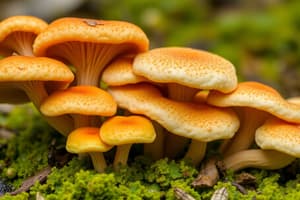Podcast
Questions and Answers
What are examples of Fungi?
What are examples of Fungi?
Molds, yeasts, and mushrooms.
Why are fungi classified in a separate kingdom from plants?
Why are fungi classified in a separate kingdom from plants?
Because they do not make their own food like plants do.
What is the function of the digestive enzymes released by fungi?
What is the function of the digestive enzymes released by fungi?
To break down large compounds into smaller substances that can be absorbed by the fungus.
What is the mass of thread-like filaments called in fungi?
What is the mass of thread-like filaments called in fungi?
How do fungi obtain their nutrients?
How do fungi obtain their nutrients?
What is the term for organisms that synthesize organic materials from inorganic materials?
What is the term for organisms that synthesize organic materials from inorganic materials?
What type of nutrition involves breaking down complex organic matter from dead organisms?
What type of nutrition involves breaking down complex organic matter from dead organisms?
What is the term for organisms that obtain energy by ingesting or absorbing organic food?
What is the term for organisms that obtain energy by ingesting or absorbing organic food?
What type of fungi get their food by digesting the dead remains of other organisms?
What type of fungi get their food by digesting the dead remains of other organisms?
What is the term for fungi that live on plants or animals and cause them harm?
What is the term for fungi that live on plants or animals and cause them harm?
Flashcards are hidden until you start studying
Study Notes
Characteristics of Fungi
- Fungi were originally classified as plants but are now classified in a separate kingdom.
- Fungi do not make their own food, unlike plants, and do not contain chlorophyll.
- Fungi feed on dead or decaying tissues.
- Fungi range in form from single-celled yeast to multicellular organisms like the honey mushroom.
- Fungi grow best in warm, humid areas.
Fungi Structures
- Fungi are made up of thread-like filaments called hyphae, which form a mass of threads called a mycelium.
- The mycelium grows throughout the source of food and releases digestive enzymes.
- The enzymes break down large compounds into smaller substances that can be absorbed into the cells of the fungus.
How Fungi Get Their Food
- Fungi absorb nutrients from their surroundings using hyphae.
- Fungi release digestive enzymes into their surroundings, breaking down organic material.
- Fungi absorb the nutrients directly into their cells.
- Some fungi digest the dead remains of other organisms.
- Others are parasites that live on plants or animals, causing them harm.
Types of Nutrition
Autotrophic Nutrition
- Autotrophs synthesize organic materials from inorganic materials.
- Most plants are autotrophs, producing their own nutrition through photosynthesis.
Heterotrophic Nutrition
- Heterotrophs obtain energy by ingesting or absorbing organic food.
- Saprophytic nutrition: saprophytes (decomposers) break down complex organic matter from dead organisms, releasing chemical elements into the soil.
- Parasitic nutrition: parasites live in or on other living organisms, receiving shelter and deriving nutrients from them, often causing harm to the host.
Studying That Suits You
Use AI to generate personalized quizzes and flashcards to suit your learning preferences.




